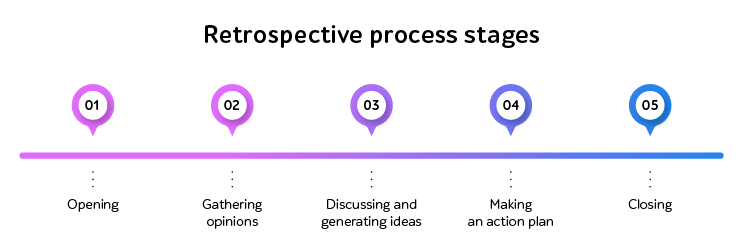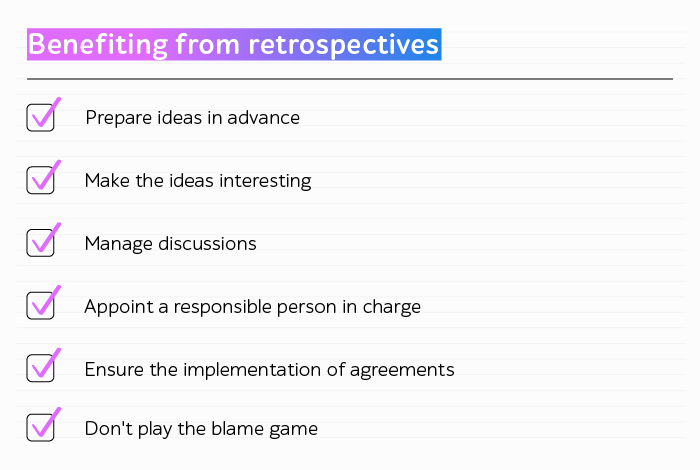
QA-focused retrospective: identifying and solving project problems
In the current conditions of uncertainty and panic, it is important to focus on enhancing the effectiveness of your teams.
Applying the best practices for optimizing project management for the long term, QA managers and team leads should ask themselves the following questions in order to help businesses bring the planned outcomes:
- How should I keep the project on track?
- How can I timely monitor and respond to external and internal amendments like the client’s business goals, market situation, atmosphere within the team?
- Are there any hidden problems that can “destroy” all the made progress?
In this article, a1qa experts are sharing their experience on the QA retrospective use and are shedding light on how it helps emphasize typical challenges as well as solve most of them.
Tackling often-observed issues
The retrospective is a system of regular “flashbacks” that can enhance crew performance and increase the transparency of the project processes for the QA manager by involving the whole team in the internal culture of excellence.
Let us define three types of retrospectives depending on the objectives and the arisen challenges:
- General
- Project
- Internal
A general meeting involves each and every project team member to take part in the problem-related discussions and make robust decisions. Everybody from testers, developers, business analysts to designers meet together to stop thinking about doing work tasks and focus on drawing a picture on the main challenges within the team as an entity. We call it a “psychotherapeutic” retrospective helping find process drawbacks and make a plan of action.
A project retrospective is carried out within the framework of a specific team or the testing crew separately from the development and other units. It can prepare participants for a general retrospective or it can be an isolated event to improve processes and solve specific problems.
The manager can also conduct the retrospective for himself or herself after finishing some of the work. It helps analyze and structure gained experience without delay to record successful management practices for future use.
The frequency of the retrospective can vary from weekly meetings to one rally at the end of the project and depends on the size of the team and the number of tasks. The most effective format is believed to be a regular meeting held every two or three weeks after the end of the iteration.
The retrospective may be conducted:
- At the end of a certain phase of the project
- After each iteration (for Agile programs)
- Upon completion of the project
- At any time when problems arise.
Even arranging retrospectives at the needed time and with the required objectives is not a way to effective meetings. Hence, one is to configure this process properly to get the maximum results. Read on to find out how to do it right.
Retrospective: 5 steps of a well-build process
As a rule, the retrospective starts with the “opening” phase, which helps commit a team for the working mood. Each participant can calmly and constructively express his or her opinion to find the optimal solutions together with other team members. Since gamification has a positive effect on the retrospective results, warm-up techniques and game elements are often used.

At the phase of gathering opinions, each participant is invited to recall the past period (iteration, release) and answer three questions:
- Which tasks did the team cope with successfully?
- Which tasks execution was not effective?
- Which issues can be tackled?
This is the most common option, but there are others. For example, the Starfish approach suggests dividing all activities into five categories and communicating on each one: what you should start doing, stop doing, keep doing, do more of, and less of something.
The overall picture becomes transparent after collecting and processing feedback from all team participants. The stage of gathering opinions helps identify the strengths and weaknesses of the processes, determine true team values, and evaluate the socio-psychological climate.
The 3rd step is the longest one, as it implies discussing each problem and generating ideas for solving them. However, before proceeding directly to the search of the perfect solutions, it is worth focusing on the most important project difficulties and discarding the minor ones.
Throughout this stage, we often apply for voting practices to define core issues. Each participant chooses from one to three points that he or she finds the most important on the project. The number of votes depends on the size of the team and the amount of the information collected at the previous steps.
The problems with a large number of votes are recognized to be high-priority. Then, the team focuses on their discussion and tries to find the most profitable solutions, normally in the brainstorm format.
After the discussion, the moderator of the process draws up an action plan where each problem with priority has an appropriate set of specific steps to solve it. It is important to determine the responsible person for each item in the plan and set a deadline for each step.
The last stage is about closing the retrospective, thanking all participants for their contribution to the processes improvement, and ensuring that all the results are documented. You can use any convenient tool to record the comments. The main thing is to care about each participant having access to all materials and artifacts of the retrospective.
6 rules for increasing retrospective efficiency
Usually, the retrospective lasts from 1 to 3 hours, depending on the size of the team and the iteration duration. To increase the efficiency of the event, participants should prepare their comments and ideas for improvement in advance.
Make sure the retrospectives do not become a routine, and the team is motivated for a constructive discussion and a joint search of the good problem resolving. For example, you can use such practices as voting to select Captain Sprint, a person who performed best during the Sprint; a discussion based on the Six Hats method; gamification with Lego, and others.
Proper management of the discussion helps participants not to go aside from the goals of retrospective and spend time productively. The ability to defuse the situation and solve conflicts allows everyone to speak freely and stay within the framework of a constructive dialogue.
In addition, the appointment of a responsible person in charge and discussion of the deadlines for all tasks encourages team members to take retrospective arrangements seriously and make more efforts to implement them.
It is also useful to review the agreements and analyze them (whether they are done/not done, worked/did not work). Therefore, the next retrospective often begins with a review of the action plan from the previous meeting and its update.
Remember that focusing on the project participants’ failures and playing the blame game are not going to work well to find the way. Only a QA team remaining cohesive can achieve better results.

The retrospective is not a miracle cure for all the problems on the project. If implemented correctly, it is a useful tool helping make the QA teamwork more transparent, keeping the positive “climate” in the crew, and identifying the pain points before they turn into a disaster.
Need professional help on the QA-related issues? Contact us!








